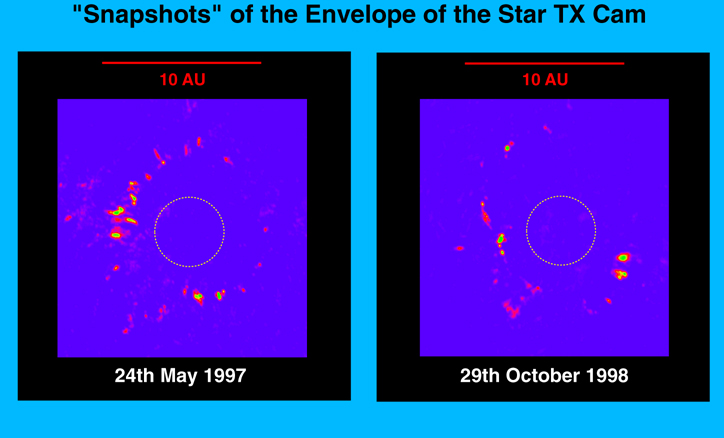Radio Astronomers Catch a Glimpse of the Sun's Future
15 August 2000
Dr Philip Diamond of the University of Manchester's Jodrell Bank Observatory and Dr Athol Kemball of the National Radio Astronomy Observatory (NRAO) in Socorro, New Mexico have for the first time made a time-lapse 'movie' of gas being ejected from the surface of a star. Their images are the most detailed ever obtained of activity close to any star other than the Sun. They will present their results at a symposium during the International Astronomical Union General Assembly in Manchester (UK) on Tuesday 15th August.
The star they studied, called TX Cam, is in the constellation Camelopardalis and lies almost 1000 light years from Earth. Its brightness changes regularly over a period of 80 weeks. It is an example of what is known as a 'Mira' variable, named after the famous variable star Mira which exhibits very regular changes in brightness on a time-scale of about a year.
As the Sun approaches the end of its life in a few billion years it will become a much more violent object than it is now. It will begin to grow quite rapidly until it swells to fill the inner part of our Solar System, swallowing the Earth and the other inner planets. Jupiter and the more distant planets may survive, but they will be subject to a considerable bombardment as the outer layers of the Sun are expelled when it begins to pulsate with a period of about a year. Eventually, much of the Sun's mass will have been thrown back into the depths of interstellar space, from whence it first came, and the Sun will shrink to a shadow of its former glory becoming what astronomers call a white dwarf.
This scenario is in the far distant future for our own star, however it is a reality now for the many thousands of Mira variable stars throughout the Milky Way. Studies of the regions close to these stars show them to be losing their outer layers at a considerable rate, they can shed an Earth mass of material every year. Astronomers can study this mass-loss process in a variety of ways and can deduce much about the mechanism by which the stars expel this material and the nature of the star in its crotchety old age.
Radio astronomers in particular can use a technique known as Very Long Baseline Interferometry (VLBI) to study this process in incredible detail. Diamond and Kemball used the National Science Foundation's Very Long Baseline Array (VLBA) to make their time-lapse movie of the gas being ejected from the surface of the star. They can do this because there are radio beacons sitting in the gas. These beacons, called masers (the radio equivalent of lasers) show up as bright spots in the radio images. The masers arise from one of the gases in the outflow, Silicon Monoxide (SiO), which emits in a narrow frequency band close to 43 GHz.
The images, made with the VLBA at 43 GHz are 500 times more detailed than is possible with the Hubble Space Telescope. The movie can be found on the internet at http://www.jb.man.ac.uk/~pdiamond/txcam44.gif. It shows the complex gas motions that arise close to the star. "They show immensely complex motions which cannot be explained by current theory" Diamond said.
The movie covers a period of 88 weeks, with observations being made every 2 weeks. "The structures that we observe in the outflow suggest that we might be seeing the effects of shock waves passing through the gas," Kemball said. "However, it is difficult to explain why most of the gas is moving away from the star whilst, at the same time, some is falling towards it."
Diamond and Kemball have continued to observe TX Cam with the VLBA. They have data covering another 80 weeks. They hope that, when this is incorporated into their movie, they will be able to understand the nature of this dying star and so cast some light on what awaits our own Sun in its dotage.

Very Long Baseline Array (VLBA) images of the gas being expelled from the surface of the star TX Cam. The two images are frames of the movie. The approximate size of the star as it would be seen in visible light is indicated by the circle. The bright spots in the image are the radio beacons caused as the SiO gas amplifies microwave radio emission. The size scale in Astronomical Units (AU) is shown above the images, 1 AU is the distance from the Earth to the Sun. 10 AU is the diameter of the orbit of Jupiter.
Background information:
Jodrell Bank Observatory forms part of the Department of Physics and Astronomy of the University of Manchester. It operates the MERLIN National Facility, an array of six radio telescopes distributed across central England and funded by the Particle Physics and Astronomy Research Council. Philip Diamond is the Director of MERLIN.
The VLBA is a continent-wide system of ten radio telescope antennas, each 25 meters (82 feet) in diameter and weighing 240 tons. They are distributed across the continental U.S., Hawaii and the U.S. Virgin Islands. Operated from a control center in Socorro, New Mexico, all ten antennas work together as if they were a single telescope more than 5,000 miles in diameter. This allows the VLBA to produce radio images hundreds of times more detailed than the Hubble Space Telescope produces using visible light.
The VLBA is an instrument of the National Radio Astronomy Observatory, a facility of the National Science Foundation, operated under cooperative agreement by Associated Universities, Inc.
A high resolution copy of the above image of two movie frames is available here.
Contacts for this release:
Dr Philip Diamond, Jodrell Bank Observatory, University of Manchester
pdiamond@jb.man.ac.uk
Phone: +44 (0) 1477 571321
Dr Athol Kemball, National Radio Astronomy Observatory, Socorro, New Mexico
akemball@nrao.edu
Phone: +1 505 835 7000


